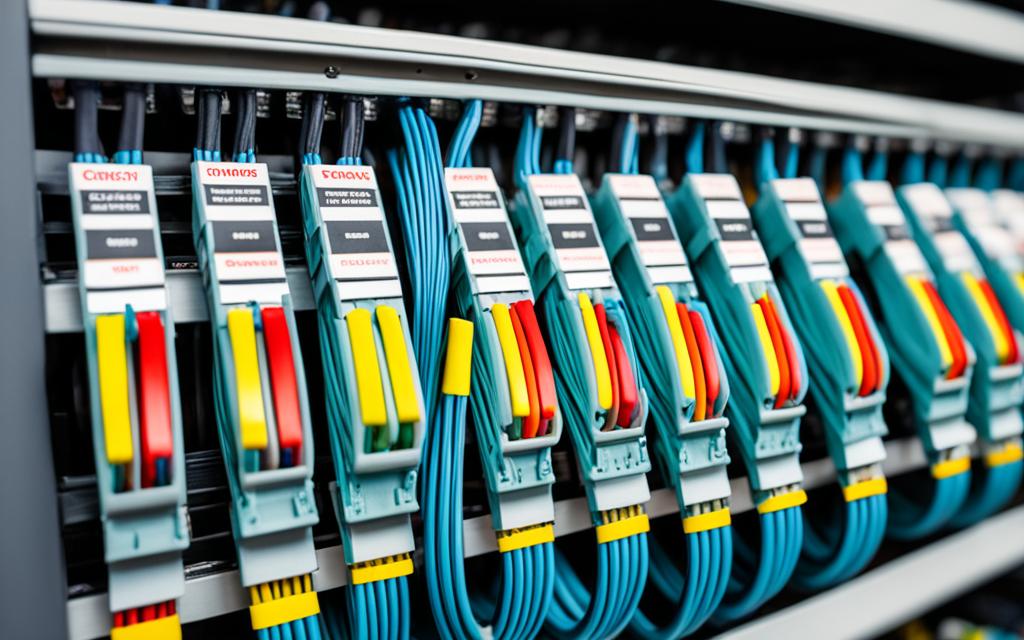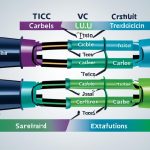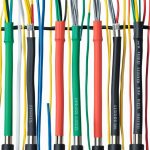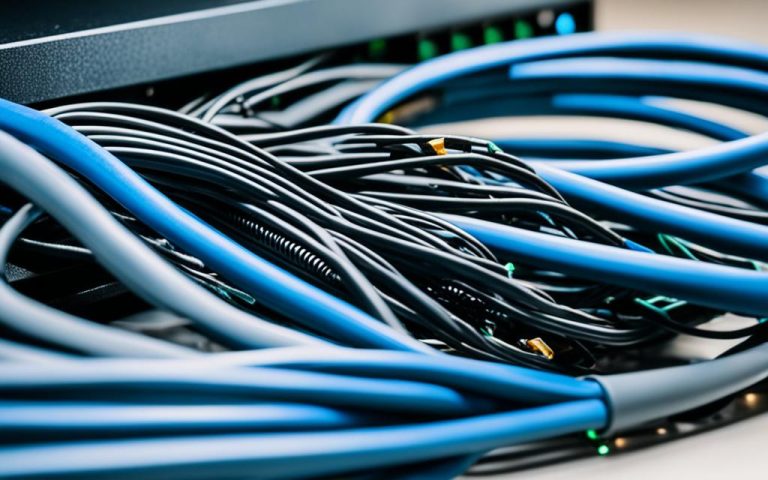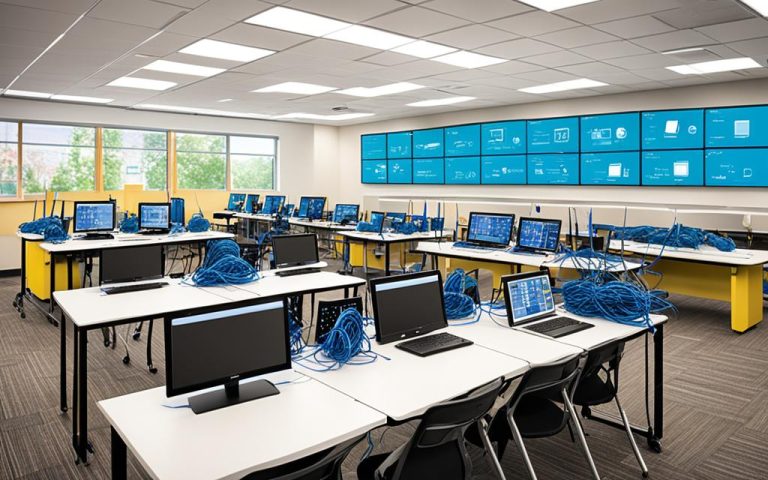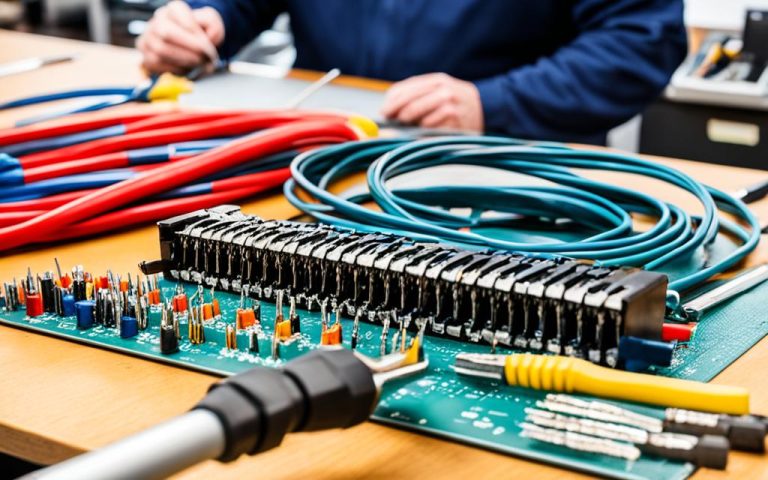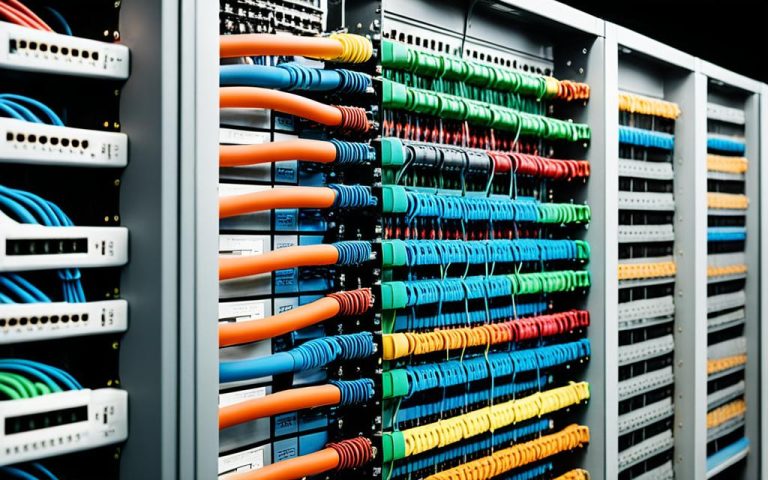Twisted pair cables play a vital role in data center infrastructure, connecting various devices and systems within the facility. To ensure a reliable and efficient network, it is essential to understand and adhere to cabling standards and compliance requirements.
Standards such as TIA/EIA-568, ISO/IEC 11801, and ANSI/BICSI-002 provide guidelines for selecting quality cabling infrastructure, including fiber-optic cables, copper cables, patch panels, and termination techniques. By following these standards, organizations can guarantee compatibility, performance, and consistency in their twisted pair cable installations.
Furthermore, planning and executing the cabling architecture, whether it is top-of-rack (ToR), end-of-row (EoR), middle-of-row (MoR), or centralized cabling, is crucial for efficient cable management, labeling, and maintaining order within the data center.
By embracing compliance and adhering to established standards, organizations can ensure seamless data transmission, scalability, standardization, cost-effectiveness, and reliability in their telecommunications networks. In the following sections, we will explore various aspects of twisted pair cable installations, including wiring standards, horizontal and backbone cabling, structured cabling, and their significance in network communication.
Understanding T568A and T568B Wiring Standards for Twisted Pair Network Cables
When it comes to terminating twisted pair network cables in modular connectors, two widely used wiring schemes are T568A and T568B. These standards dictate the color assignments for pin locations, providing consistency and compatibility in network installations.
While T568A follows an older phone standard, T568B is based on a commercial standard. Both schemes are valid, as long as both ends of the cable are wired the same. In other words, if you choose T568A for one end, you must use T568A for the other end as well, and the same applies to T568B.
The differences between T568A and T568B do not affect network performance unless there is a mix-up where one end of the cable uses T568A and the other end uses T568B. Such a configuration would result in a crossover cable, which is not suitable for regular network communication.
Choosing the right wiring scheme depends on various factors, including customer preference, contractual requirements, and compatibility with existing equipment. It is important to adhere to a consistent wiring scheme throughout your network installation, ensuring reliable and efficient network communication.
Key takeaways:
- T568A and T568B are wiring schemes for terminating twisted pair network cables.
- Both schemes are valid as long as both ends of the cable are wired the same.
- Using different wiring schemes on each end creates a crossover cable, which hinders network communication.
- Choose the appropriate wiring scheme based on customer preference, contractual requirements, and equipment compatibility.
- Adhere to a consistent wiring scheme for reliable and efficient network communication.
Importance of Horizontal Cabling in Telecommunications
Horizontal cabling serves as the backbone of telecommunications systems, connecting the telecommunications room to individual work areas or outlets on a specific floor or area. This vital infrastructure ensures seamless data transmission, scalability, standardization, cost-effectiveness, versatility, and reliability.
Various types of cables are used in horizontal cabling, including unshielded twisted pair (UTP), shielded twisted pair (STP), coaxial, and fiber optic cables, depending on the specific networking requirements. These cables provide the necessary bandwidth and performance for data transmission, ensuring efficient communication throughout the telecommunications network.
Compliance with industry standards is crucial when designing and installing horizontal cabling systems. Standards such as TIA-568-C.0 and ISO/IEC 11801 provide guidelines for cable selection, installation practices, and performance requirements. Adhering to these standards ensures compatibility, interoperability, and reliability in telecommunications systems.
Proper planning, compliance with standards, and implementation of best practices are essential for a reliable and efficient horizontal cabling installation. Factors such as cable routing, cable management, avoiding electromagnetic interference, and testing and verification play a crucial role in achieving optimal performance and minimizing downtime.
The Benefits of Horizontal Cabling in Telecommunications
Implementing a well-designed horizontal cabling system offers numerous benefits:
- Seamless Data Transmission: Horizontal cabling facilitates smooth and uninterrupted data transfer between the telecommunications room and individual work areas, ensuring efficient communication.
- Scalability: Horizontal cabling provides the flexibility to accommodate future growth and technological advancements, allowing for easy expansion and upgrades as needed.
- Standardization: Following established standards ensures consistency and compatibility among different components of the cabling system, making maintenance and troubleshooting more manageable.
- Cost-Effectiveness: Horizontal cabling simplifies infrastructure management, reduces the need for additional equipment, and minimizes downtime, resulting in cost savings over the long term.
- Versatility: Different types of cables can be deployed in horizontal cabling, allowing for the support of various applications and networking requirements.
- Reliability: A properly installed and maintained horizontal cabling system enhances system performance, reduces signal degradation, and improves overall network reliability.
Proper planning, compliance with standards, avoiding electromagnetic interference, proper cable management, and testing and verification are essential for a reliable and efficient horizontal cabling installation.
| Horizontal Cabling Benefits | Description |
|---|---|
| Seamless Data Transmission | Ensures smooth and uninterrupted data transfer between the telecommunications room and individual work areas. |
| Scalability | Allows for easy expansion and upgrades to accommodate future growth and technological advancements. |
| Standardization | Ensures consistency and compatibility among different components of the cabling system, simplifying maintenance and troubleshooting. |
| Cost-Effectiveness | Reduces infrastructure management complexity, reduces the need for additional equipment, and minimizes downtime, resulting in long-term cost savings. |
| Versatility | Supports various applications and networking requirements through the use of different cable types. |
| Reliability | Enhances system performance, reduces signal degradation, and improves overall network reliability. |
Understanding Backbone Cabling and its Role in a Structured Cabling System
Backbone cabling, also known as vertical cabling, is an integral component of a structured cabling system. It serves the purpose of interconnecting various parts of the network infrastructure, including telecommunications rooms, equipment rooms, and entrance facilities. This backbone cabling acts as the backbone of the entire network, facilitating data transmission between different networks and providing scalability and redundancy.
Within the backbone cabling system, there are two critical types of cables utilized: twisted pair and fiber optic cables. These cables play a crucial role in supporting various applications and ensuring optimal network performance.
Twisted pair cables, specifically Category 6 (Cat6) and Category 6a (Cat6a), are widely used for backbone cabling due to their ability to carry high-speed data transmission over long distances. They provide reliability and flexibility, making them suitable for interconnecting network equipment within a structured cabling system.
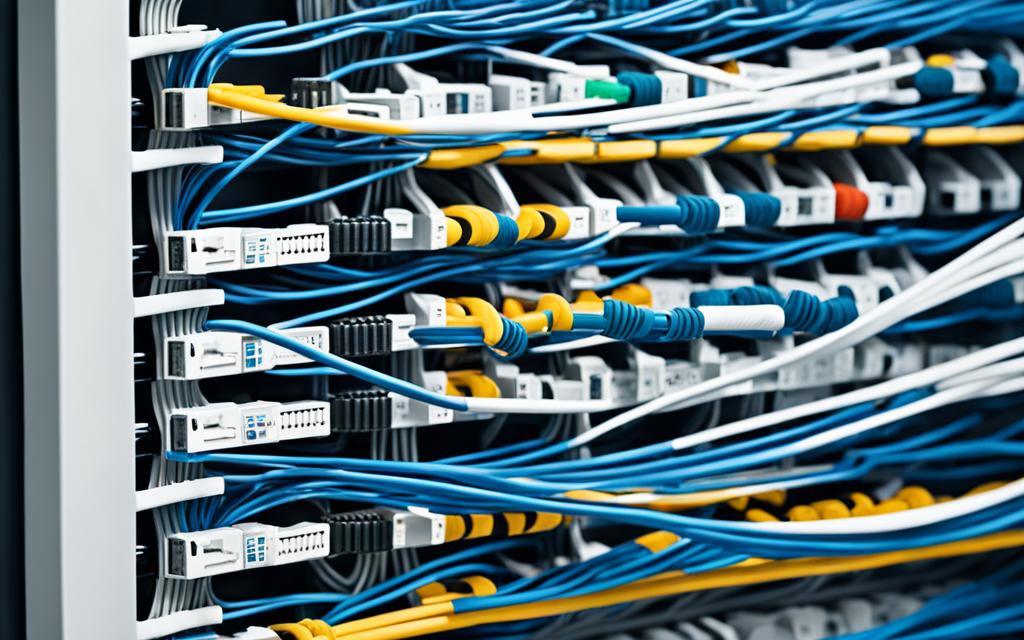
Fiber optic cables, on the other hand, offer unparalleled speed and bandwidth capabilities, making them ideal for transmitting large amounts of data over longer distances. With their ability to support high-speed data transmission and provide immunity to electromagnetic interference, fiber optic cables are the preferred choice for backbone cabling in modern networking environments.
Understanding the importance of backbone cabling is paramount when designing and implementing a structured cabling system. It ensures a robust and efficient network that can handle the demands of modern data transmission.
Benefits of Backbone Cabling:
- Facilitates data transmission between different networks within a structured cabling system
- Provides scalability and redundancy for network expansion and fault tolerance
- Supports various applications and ensures optimal network performance
Backbone cabling is the backbone of a structured cabling system, connecting various parts of the infrastructure and enabling efficient data transmission between networks.
Proper planning and implementation of backbone cabling, along with adherence to industry standards such as TIA-568-C.0 and ISO/IEC 11801, are essential for building a reliable and efficient network. A well-designed backbone cabling system lays the foundation for seamless data transmission and ensures the network’s ability to adapt and scale as technology advances.
Importance of Structured Cabling in Horizontal Cabling Systems
Structured cabling is an essential component of horizontal cabling systems, providing a solid foundation for efficient data transmission and network performance. Its importance lies in its ability to support scalability, reduce downtime, simplify management, improve data speed and capacity, and accommodate multiple applications.
Proper planning is crucial when implementing structured cabling systems to ensure seamless integration and optimal performance. Compliance with standards, such as TIA-568-C.0 and ISO/IEC 11801, guarantees a reliable and efficient installation.
Avoiding electromagnetic interference is also essential for maintaining signal integrity and minimizing disruptions. By implementing effective cable management techniques, such as routing cables away from potential sources of interference, organizations can promote a stable and reliable network environment.
Benefits of Structured Cabling in Horizontal Systems
Let’s take a closer look at why structured cabling is so important:
- Scalability: Structured cabling provides the flexibility to easily add or relocate network devices without the need for extensive rewiring. This scalability is crucial for businesses that anticipate growth or frequent reconfiguration of their network infrastructure.
- Reduced Downtime: With structured cabling, troubleshooting and repairs become more efficient. The organized and standardized configuration allows technicians to quickly identify and rectify any issues, reducing network downtime and minimizing disruptions to business operations.
- Simplified Management: A well-designed structured cabling system allows for easy identification, labeling, and management of network components. This streamlines maintenance tasks, simplifies future expansions, and promotes a more organized and efficient network environment.
- Cost-effectiveness: Implementing structured cabling may require an upfront investment; however, it pays off in the long run. The standardized infrastructure reduces the need for additional equipment and simplifies maintenance, resulting in cost savings over time.
- Improved Data Speed and Capacity: Structured cabling ensures optimal performance by minimizing signal loss, crosstalk, and other forms of interference. This results in improved data transfer speeds and increased network capacity, supporting the demands of modern-day applications and technologies.
- Support for Multiple Applications: A well-designed structured cabling system supports various applications, such as data, voice, video, and multimedia. This versatility enables organizations to easily adapt to evolving technologies and efficiently meet their communication needs.
Implementing structured cabling is a strategic choice that delivers long-term benefits, supporting both current and future network requirements.
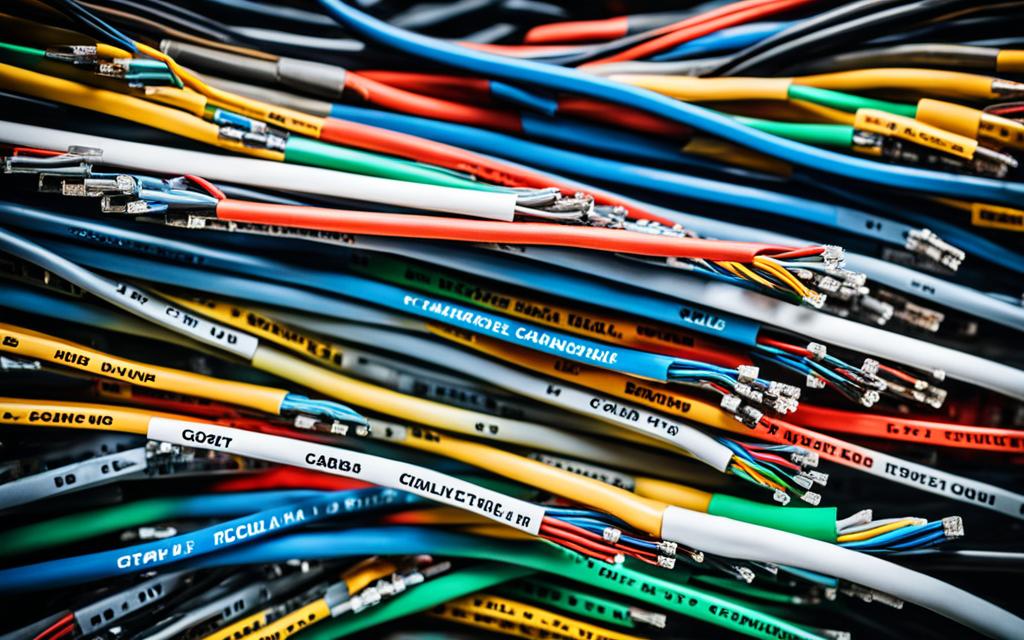
| Structured Cabling Advantages | Structured Cabling Benefits |
|---|---|
| Scalability | Supports future growth and changes |
| Reduced Downtime | Minimizes disruptions and speeds up troubleshooting |
| Simplified Management | Eases maintenance and expansions |
| Cost-effectiveness | Reduces the need for additional equipment and maintenance |
| Improved Data Speed and Capacity | Enhances network performance and efficiency |
| Support for Multiple Applications | Accommodates various communication needs |
Conclusion
Ensuring compliance with industry standards and best practices in twisted pair cable installations is paramount for achieving optimal network performance and reliability. By adhering to established cabling standards like TIA/EIA-568 and implementing proper wiring schemes such as T568A or T568B, organizations can create a solid foundation for their telecommunications networks.
In addition to complying with standards, implementing structured cabling practices is essential. This includes designing and installing proper horizontal and backbone cabling systems that facilitate seamless data transmission and support the scalability and standardization of the network. Structured cabling brings numerous benefits, including reduced downtime, simplified management, cost-effectiveness, improved data speed and capacity, and support for multiple applications.
Organizations must prioritize compliance with these standards and practices to ensure the reliability and efficiency of their network infrastructure. Proper cable management, testing, and verification are key components of achieving successful compliant installations. By doing so, organizations can establish scalable, standardized, and cost-effective telecommunications networks that enable seamless data transmission and meet the increasing demands of modern businesses.
FAQ
What are the cabling standards that need to be followed for twisted pair cable installations?
The cabling standards that need to be followed for twisted pair cable installations include TIA/EIA-568, ISO/IEC 11801, and ANSI/BICSI-002.
What are T568A and T568B wiring standards for twisted pair network cables?
T568A and T568B are wiring schemes for terminating twisted pair network cables in modular connectors. They differ in color assignments for pin locations. T568A follows an older phone standard, while T568B is based on a commercial standard. Both schemes are valid as long as both ends of the cable are wired the same.
What is the importance of horizontal cabling in telecommunications?
Horizontal cabling connects the telecommunications room to individual outlets or work areas, serving as the central infrastructure for data transmission on a specific floor or area. It ensures seamless data transmission, scalability, standardization, cost-effectiveness, versatility, and reliability in telecommunications systems.
What is backbone cabling and what role does it play in a structured cabling system?
Backbone cabling, also known as vertical cabling, interconnects various parts of a structured cabling system, including telecommunications rooms, equipment rooms, and entrance facilities. It is responsible for transmitting data between different networks and provides scalability and redundancy.
Why is structured cabling important in horizontal cabling systems?
Structured cabling plays a crucial role in horizontal cabling systems due to its scalability, reduced downtime, simplified management, cost-effectiveness, improved data speed and capacity, and support for multiple applications.
How important is compliance with standards in twisted pair cable installations?
Ensuring compliance with standards and best practices in twisted pair cable installations is crucial for optimal network performance and reliability. This includes adhering to cabling standards such as TIA/EIA-568, understanding wiring schemes like T568A and T568B, implementing proper horizontal and backbone cabling systems, and following structured cabling practices.

